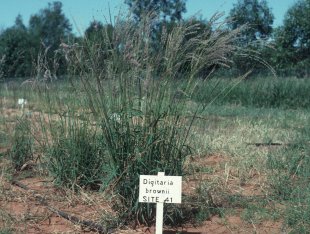
Cotton panic grass
SCIENTIFIC NAME: Digitaria brownie
CATEGORY: C4 perennial
IDENTIFICATION TIPS
- Tufted, hairy, warm-season perennial, usually 25-45cm high, but sometimes to 80cm
- Numerous slender branched stems, that are usually hairy at their base
- Flat, soft leaves become twisted and crumpled with age and the leaf edges are often wavy
- Seedhead is 6-11cm long with 1-7 (usually 3) erect or spreading branches that normally bear spikelets to their base
- Spikelets on stalks 4-8mm long and covered in silky, brown or purple hairs making the spikelets appear like pieces of cotton wool
- Flowers mostly in summer and early autumn
CLIMATIC & SOIL REQUIREMENTS
- Widespread in a variety of habits
- Common on lighter soils and in lightly grazed pastures
- Highly drought tolerant and low to moderate frost tolerance
GRAZING & NUTRITIONAL VALUE
- Moderate to high grazing value
- Digestibility ranges from 40-70%
- Crude protein 4-14%
MANAGEMENT STRATEGIES
- Desirable summer grass that is readily eaten by stock and of moderate to high quality when young
- Moderately productive, growing rapidly after summer rain
- Plant populations diminish over dry seasons and re-establish in wet seasons, but it needs heavy extended summer rain to establish from seed
- Most common in areas not frequently grazed, but otherwise only found as scattered plants
- Conservatively stock or provide rests periods to maintain populations. Resting pastures following heavy summer rains will aid establishment and promote seed set
SIMILAR PLANTS
- Needs close inspection of seedheads to distinguish between other species of Digitaria
- The base of the seedhead branches are bare for 5-10cm in finger panic grass (D. coenicola)
- Spreading umbrella grass (D. divaricatissima) has long, stiffly-spreading branches and the spikelets are only moderately hairy

(Flowering plant: I Toole)

